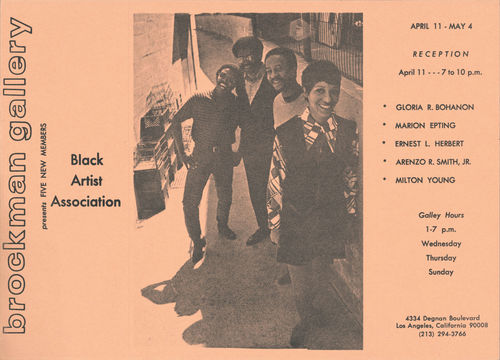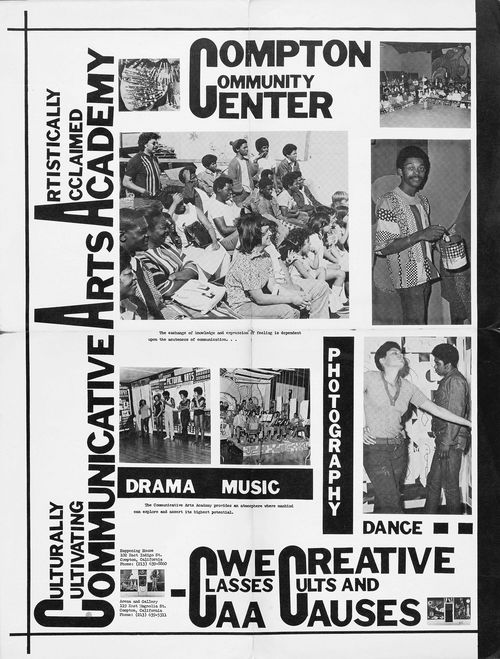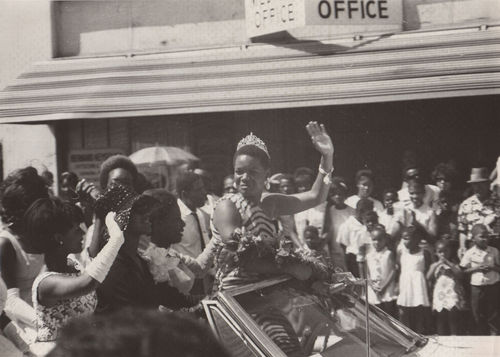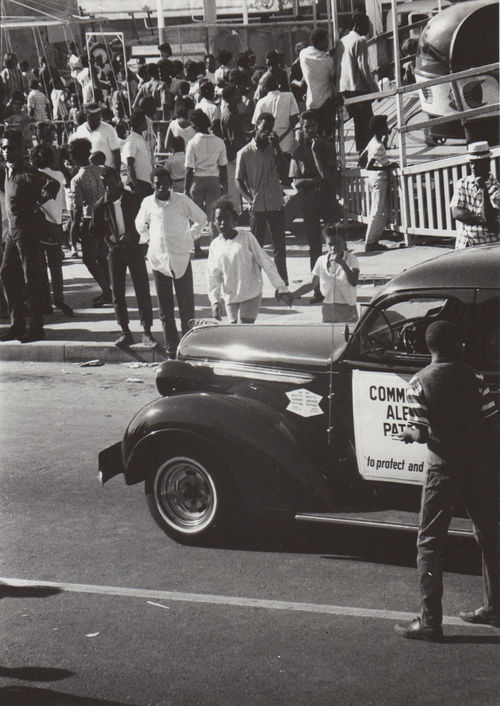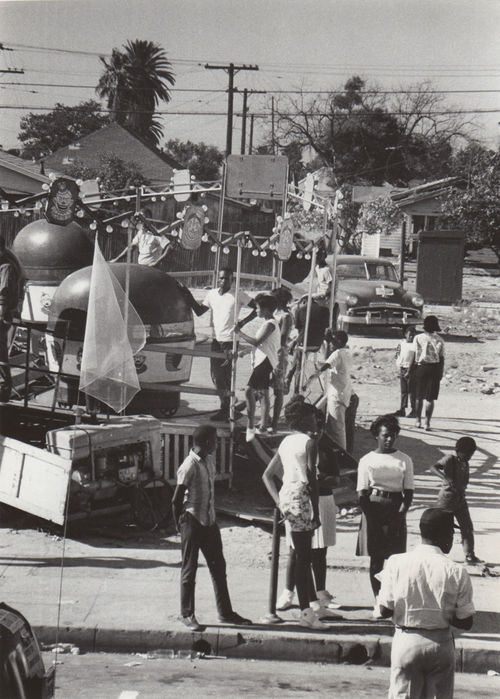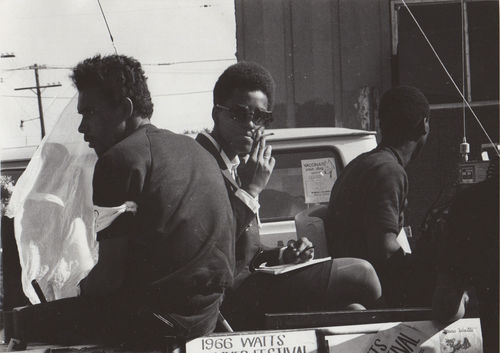The Art of Creative Survival
During the 1960s and 1970s black Los Angeles produced dozens of cultural groupings that sought both to foster a new art and to generate a new relationship between creativity and community. These organizations were defined in part by their variety: theater companies like the Inner City Cultural Center and the Performing Arts Society of Los Angeles; community arts projects like the Mafundi Institute and St. Elmo Village; galleries like Brockman and Gallery 32; formal bodies like the Watts Writers Workshop and informal tendencies like the cohort of avant-garde black filmmakers who trained at the University of California, Los Angeles (UCLA). Their reach extended beyond Watts and South Los Angeles, past the city limits even. Altadena sheltered early associations of black visual artists, and it was from Pasadena that Ridhiana Saunders produced the journal Nigger Uprising. Compton was home to the Communicative Arts Academy, and even Riverside and San Bernardino hosted short-lived collectives associated with the Watts Writers Workshop and the Pan Afrikan Peoples Arkestra. These groupings encompassed visionary leaders and a mass base, generated furious debates and ideological positions, and participated in both critical moments and ongoing campaigns. In total, their reach and influence can be said to match or even surpass those of both mainstream civil rights organizations and radical nationalist formations. For this reason, it is appropriate to consider the Black Arts Movement in Los Angeles as a social movement in its own right.
If we heed Robin D. G. Kelley's acerbic reminder that the Black Arts Movement was not so much about "race riots and dashikis" but rather was "a self-conscious collective effort to promote . . . art about liberation and freedom,"# then it becomes clear that there are many ways to tell the story of what happened in Los Angeles during this period. One might, for example, adopt an intergenerational frame, expanding the timeline to encompass everything from the work of prewar figures such as William Grant Still and Louise Beavers to the post-1992 contributions of the KAOS Network and the World Stage. One might choose to tell the story through the critical creative and organizational interventions of black women artists and activists such as Miriam Matthews, Ruth Waddy, Linda Hill, Jayne Cortez, Marla Gibbs, Ridhiana Saunders, and others. One might select a particular figure whose trajectory illustrates the intersection between creativity, collectivity, solidarity, and hard work; Gibbs comes immediately to mind. One might explore how and why artists working in visual, dramatic, and musical media all saw abstraction as a means by which to develop racially coded work, thus producing an art unlike that typically favored by socially concerned artists. Or one might adopt a comparative conceptual frame attuned to examples of cross-generic work: films like Passing Through (1977), Larry Clark's seminal attempt to link the cinematic and jazz avant-gardes via a message of creative control and political struggle; the poetry of visual artists Noah Purifoy and Betye Saar; the written, sculpted, and sung collaborations between Melvin Edwards and Jayne Cortez. All of these approaches—and the short list above is hardly exclusive—acknowledge the scope and scale of what Roderick and Rozzell Sykes called "the art of creative survival."# The account that follows is one such story—a brief overview of dramatic, literary, and musical parallels that took place alongside the visual art presented in Now Dig This! It traces the trajectories of a number of critical institutions and individuals, and explores what we gain by expanding our focus across genres and geographies, across ideologies and institutions.
Perhaps more than any other artistic medium, theater highlights the tremendous variation present in the cultural activities of L.A.-based African American artists of the 1960s and 1970s. Consider the distinct origins, viewpoints, missions, and activities of organizations such as the Ebony Showcase Theater, the Inner City Cultural Center (ICCC), and the Performing Arts Society of Los Angeles (PASLA). In each case, a specific vision of the relationship between the dramatic arts and the larger black community took hold. The Ebony Showcase Theater sought to develop professional talent by utilizing all-black casts in mainstream and experimental plays written by white playwrights. The ICCC pioneered what would later be called "multiculturalism," seeing art as a tool for social inclusion and bringing black writers and performers into dialogue with Asian American and Mexican American actors, playwrights, and works. PASLA founder Vantile Whitfield, by contrast, publicly identified his company with the cultural nationalist philosophy of Ron (Maulana) Karenga, while a singing troupe affiliated with the company performed as part of the Angela Is Happening benefit for imprisoned radical Angela Davis. In each case, the tripartite focus on creative control, community service, and innovative art was present. At the same time, the differences in the philosophies and missions of these organizations, all flourishing alongside one another, meant that the local black community had distinct choices in terms of defining "black art" in the context of theater.#
Judged on its longevity, its influence, and the memories of its participants, the Ebony Showcase Theater stands out as a singularly successful institution. Founded in 1950 by Nick and Edna Stewart, Ebony Showcase functioned to incubate theatrical talent for five decades, closing only in 1996. Its reach extended backward as well, linking almost a century of black expressive culture and connecting the Harlem Renaissance, midcentury modern, black arts, and postmovement cultural moments. As a child, Nick Stewart had lived directly across the street from New York's Cotton Club. The cultural milieu of Renaissance-era Harlem exercised a powerful pull on the young man, who abandoned his schooling—after all, he observed, "everybody with an education was a Pullman porter"—to work in the vaudeville circuit.# When urged by actress Mae West to consider a move to the West Coast, Stewart relocated to California, where he rapidly became part of a small coterie of African Americans who landed regular speaking parts in Hollywood films. In trying to find ways to infuse menial characters with dignity, Stewart pursued a strategy common among black actors prior to the rise of the modern civil rights movement. This strategy might be seen as one component of what scholars term "racial uplift ideology," or the idea that assertions of black morality and steady economic progress could wear down white racism. Such a political position is evident in the Stewarts' vision of the Ebony Showcase Theater as a facility that would prepare black actors for the white roles from which they were excluded. As a result, during its first twenty years, with the exception of an important regularly televised talent show, the theater gave little active attention to showcasing works by black playwrights or seeking to develop a predominantly black audience for the plays it presented.
By contrast, the principal cofounders of the Inner City Cultural Center, C. Bernard "Jack" Jackson and J. Alfred Cannon, envisioned an organization dedicated less to helping prospective black actors succeed in Hollywood than to providing a creative outlet for the nonwhite communities of Los Angeles as a whole. Emerging from the embers of the Watts rebellion in 1965, the ICCC would expand into a major partnership with Los Angeles schools; receive major infusions from philanthropic organizations; begin publishing a quarterly magazine; host minority playwrights from around the nation; and open a theatrical training institute that offered vocational, language (including Japanese, Spanish, and Swahili), and movement arts classes. Eventually, the ICCC would diversify into subsidiary institutes with specific missions, all housed in a newly renovated facility. By 1973 a cast of celebrity teachers and volunteers had been brought in, and the center was offering vocational certificates as well as associate's and bachelor's degrees in music, dance, and theater arts.
A diverse board of directors was responsible for shaping the vision of the ICCC. Partially as a result of this diversity, regular ideological disputes broke out over the purpose and direction of the organization, as well as over play selections and the center's early insistence on hiring mixed casts that included blacks, whites, Asian Americans, Latinos, and Native Americans. During the inaugural season, one contentious decision was the hiring of a prominent white director from the East Coast to shepherd the institution, which had a stated commitment to providing art that would be relevant to black Los Angeles audiences in the aftermath of Watts. Prominent white supporters, among them Gregory Peck, envisioned the theater as a means to expose African Americans to classic art so as "to affect positively the lives of the people in the minority and economically deprived areas."# This view, while not totally foreign to Jackson, fell well short of his own conviction that the theater could be an agent of transformation, rather than simply an avenue toward inclusion into the mainstream of American or, even more broadly, Western society.
The complex and intriguing ICCC served as a mainstay of Los Angeles–area community arts activity for more than two decades. Ebony Showcase lasted more than forty years. Each institution trained hundreds of actors, set designers, and other theater personnel, and each obtained a national reputation and scope. By contrast, the Performing Arts Society of Los Angeles (PASLA), founded by Vantile Whitfield in 1965, closed after only eight years, and for most of its tenure remained a smallish outfit of about thirty people, more than half of whom had no previous dramatic experience. Nevertheless, PASLA was a critical presence on the L.A. theater scene, consciously casting itself as a "black" theater offering African American–themed plays within a larger vision of the "development and expansion of black art for the liberation of black people."# PASLA members adopted Swahili names and operated as a kind of surrogate family; many members, Whitfield included, professed familiarity with and support for the general viewpoint of cultural nationalism. In this way, PASLA was more akin to explicitly political theater projects born of the Black Power movement such as the Black Arts Repertory Theatre/School in Harlem, the Miami-based Afro Arts, Detroit's Concept East, and the Free Southern Theater in Jackson, Mississippi.
In many of the early treatments of black arts activity during the 1960s and 1970s, theater and literature were taken as the two central areas of emphasis. Anthologies such as New Black Voices represent this general tendency, loading up on pieces dealing with poetry and drama to the detriment of dance and visual art. This was part of a general paucity of works on the subject as whole. Writing in 1991, David Lionel Smith lamented the lack of scholarship on the Black Arts Movement, noting that basic questions about origins, styles, locations, and trajectory awaited serious attention.# In the time since, thankfully, many of these questions have begun to be studied and answered. Interestingly, much of this scholarship continues to treat the Black Arts Movement as a primarily literary phenomenon. James Smethurst's important and wide-ranging survey, for instance, is titled The Black Arts Movement: Literary Nationalism in the 1960s and 1970s. Even a cursory search for information on the movement is far more likely to turn up figures such as Amiri Baraka, Sonia Sanchez, Haki Madhubuti, Larry Neal, and Gwendolyn Brooks than creators such as Jayne Cortez, David Hammons, or even Sun Ra. The reasons for this are hardly surprising, as writers were among the most vocal avatars of new black aesthetic sensibilities and were responsible for founding some of the Black Arts Movement's principal organizations.
Yet in the case of writing, Los Angeles stands apart from much of what we commonly think of as "black" writing during this time. Neither the multiple cohorts of the Watts Writers Workshop, nor the writers affiliated with Saunders's Nigger Uprising, nor jazz poets like Kamau Daáood, nor writers like Will Alexander and Wanda Coleman fit the mold of creators motivated by the "destruction of the white thing, the destruction of white ideas, and white ways of looking at the world."# Perhaps this was a matter of geography, for, as Eugene Redmond observed, "the poets of the East, South, Midwest, and near West are a bit more than a hop, skip, and jump from California," though he did note how the Californians' access to mass media meant that their work was often familiar to contemporaries beyond their own region.# In reality, Redmond's comments are more applicable to Los Angeles than to California as a whole, since the presence of Baraka, Sanchez, Marvin X, and others at the San Francisco Black House meant that the poetics-in-formation of the Black Arts Movement mainstream was well represented in the Bay Area.
Los Angeles produced a diverse literary landscape. The best-known project, of course, was the Watts Writers Workshop. Originally the brainchild of white screenwriter Budd Schulberg, it grew from a liberal effort to connect Watts "to what you might term the outside world" and to make it into a critical community cultural resource.# Aided by major grants from the Rockefeller Foundation and hampered by the same police malfeasance that afflicted black radical organizations, workshop participants published widely, testified before Congress, and opened satellite projects across Southern California. By 1968, when internal debates over the nature and tone of members' writing caused an organizational split at the workshop, Los Angeles could increasingly boast a vital black literary scene, with poets and writers pursuing a broad range of creative idioms in a variety of venues. Nigger Uprising, for example, published local writers alongside reviews of black art shows at local galleries, updates on the Biafran civil war, and examinations of the political debates that divided local activists. Between the late 1960s and mid-1970s, moreover, musician-writers such as Daáood and the Watts Prophets joined forces with the likes of Alexander and Coleman, leading to a rich cross-fertilization of poetic and musical voices.
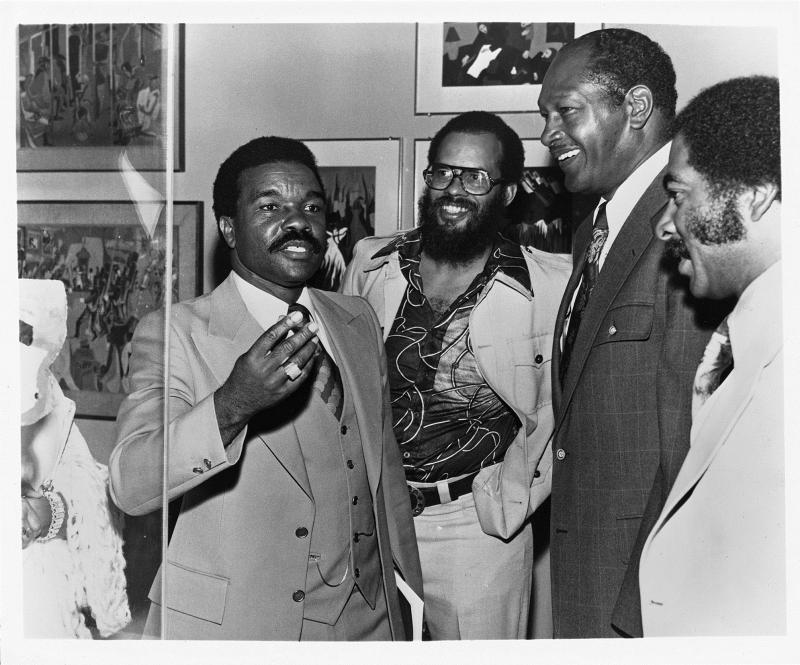
Black music has a long and distinguished history in Los Angeles. A local "Negro" Musicians' Union had existed since 1918, and music instructors constituted a major percentage of the city's nascent black professional class in the years immediately before and after World War I. These teachers exercised a significant social and political influence, with figures such as John Gray, William Wilkins, and Genevieve Barnes Lewis teaching thousands of students, publishing regular columns in the Eagle and Sentinel, and generally working for the "uplift of the race." Instruction in both jazz and European art music took place, and there is little exaggeration in the argument that two full generations before the emergence of the modern civil rights movement, both musical instruction and the idea of music as a core component of African American collectivity were deeply entrenched in Southern California's black communities. Recalling the celebrated role of prewar Central Avenue only adds to the general picture. Imagine: today there are fewer than a dozen live music venues that cater to African Americans in all of South Los Angeles—an area larger than Manhattan. Six or seven decades ago, one could find that many clubs on a single block.
It is small wonder, then, that the widespread political and creative mobilization that took place during the 1960s would find strong expressions in the musical world. At the center of this process were two configurations: the New Art Jazz Ensemble of Bobby Bradford and John Carter, and the Pan Afrikan Peoples Arkestra/Union of God's Musicians and Artists Ascension founded by Horace Tapscott. Carter and Bradford met through Ornette Coleman, who had lived in Los Angeles prior to moving to New York. The duo began rehearsing together regularly in 1965, ultimately developing a strong musical bond based in part on a shared insistence on challenging themselves and maintaining creative autonomy. Both Carter and Bradford were dedicated experimentalists, eschewing the material of other composers in favor of original compositions. Carter saw this as basic to the group's creative process. No two performances were alike, and no attempt was made to re-create previously attained heights. Carter described his compositions as "skeletal," adding, "we try to play so that anybody can lead the way." The result was a shared musical responsibility in which "the only restriction on freedom of approach is that each player must listen . . . and . . . cooperate toward group expression within the mood."# The ensemble would ultimately record four albums together, and Bradford would collaborate on Carter's epic 1980s project Roots and Folklore: Episodes in the Development of American Folk Music, a five-volume effort to synthesize the whole of African American history, from the Continent through the Middle Passage, slavery, and Jim Crow to the present. The project anticipated (and surpasses) Wynton Marsalis's Pulitzer Prize–winning oratorio Blood on the Fields, though Roots and Folklore avoided Marsalis's sober classicism and musical certainty by favoring "no unequivocal statements, no coming full circle," instead choosing to play the historical evolution of African American experience as "more a change of scenery than of circumstance."#
The Pan Afrikan Peoples Arkestra was founded in 1961, a key moment in the cultural history of black Los Angeles. This year saw music teacher Samuel Browne depart Jefferson High School for suburban, beachside, and overwhelmingly white Pacific Palisades High School. With him went his famous jazz band courses and musical curriculum. Among the first African Americans hired to teach at a Los Angeles–area secondary school, Browne had shaped a critical core of local jazz talent since the time of the Hoover administration. His students included such later luminaries as Tapscott, Dexter Gordon, Chico Hamilton, Buddy Collette, Don Cherry, and Art Farmer, among others, and it was common for students from other area schools to drop in, as did professionals such as Duke Ellington, W. C. Handy, and William Grant Still. Although Browne's reasons for leaving Jefferson were personal—his band classes had seen steadily declining attendance—his exit coincided with the larger departure of the black middle class from the segregated environs of South L.A. Thus, while the Arkestra came out of the same general national moment that produced parallel claims for creative control and experimental music in places such as New York and Chicago, in its local context Tapscott's effort to both preserve and extend African American musical traditions and idioms filled a particular void in the local community.
Within black Los Angeles, the Arkestra made specific cultural contributions. First and foremost, the collective operated as a community resource, appearing in parks, at schools, and monthly at the Immanuel United Church of Christ as part of a series of community outreach activities sponsored by the Reverend Edgar Edwards. When set against the growing economic dislocation of black life during the 1970s and 1980s, the Arkestra's insistence on providing a musical, cultural, and social home for its floating membership of more than two hundred professional and amateur musicians is all the more striking. The group offered a singular musical vision as well. The musicians associated with the project, in its various configurations, produced pioneering examples of avant-garde jazz at the same time that they performed works by a wide range of African American composers. At precisely the moment that desegregation and the renewed commodification of African American music were combining to drive black-owned radio stations under, the Arkestra exposed a multigenerational audience to compositions that literally could not be heard anywhere else.# Collaborations with writers, visual artists, filmmakers, and actors were a regular feature of the Arkestra's performative practice, and the ultimate improvisational vision of the group reflected the creative input of artists working across a wide range of genres. Finally, the collective struggled to control the processes of musical production and dissemination. "Many of the Arkestra's live concerts have been recorded," noted Tapscott, "but we have chosen not to release them until the proper deal is made."# Carter concurred, adding, "I just never have gotten on to the idea of getting ten percent of something that is all mine."# Tapscott generally regarded the recording of albums—in the absence of full creative control—as counterproductive to preserving and extending a community-oriented musical vision, a view that put him very much in line with avant-garde colleagues throughout the United States.
Without belaboring the association between free jazz and the Black Power movement, it is fair to say that a common thread of self-determination did emerge. The general influence of musicians can be seen in the release, mere weeks apart, of jazz albums—Kawaida and Seize the Time, respectively—by political rivals the US organization and the Black Panther Party. The effort to produce records that would express the two groups' competing ideals of cultural and revolutionary nationalism suggests the need to include the activities of radical nationalist political organizations in a discussion of the dramatic, literary, and musical components of L.A. black arts activity during the 1960s and 1970s. Although we tend to regard the Black Arts Movement as the "cultural" counterpart of the Black Power movement, James Smethurst argues astutely that "one could just as easily say that Black Power was the political wing of the Black Arts Movement."# Certainly, a view that proposes the "cultural" and "political" as connected, or equivalent in importance, can be found in the earliest iterations of Black Power. The program of Malcolm X's Organization of Afro-American Unity made repeated reference to the role of culture in producing revolutionary consciousness. Robert Williams's Radio Free Dixie broadcasts from Cuba combined updates on the freedom struggle in the American South with free jazz and the most political performers of soul music and R&B. And both Larry Neal and Askia Touré, two architects of the Black Arts Movement, were affiliated with the Revolutionary Action Movement.
A similar story can be told in Los Angeles. A web of mutual links bound the city's creative and political avant-gardes together, whether one talks of the countercultural enclaves of Venice and Echo Park, built on the foundations of the nexus of the Beats and the old left; the radicalization of raza artists, activists, students, and workers in the barrios of the greater Eastside; the ties between the Black Panther Party and the Arkestra, and between the Mafundi Institute, the ICCC, and the US organization; the installations and festivals put on by black student unions on high school, junior college, and Cal State campuses; or the activities of figures such as Jayne Cortez and Jimmy Garrett, who crisscrossed the Student Non-Violent Coordinating Committee, the Black Arts Movement, and the worldwide circuits of Black Power. But these direct links tell only part of the story; broader undertones marked this milieu, as captured in John Outterbridge's comment to an interviewer: "In a way, we were all Panthers."#
These points of contact should hardly come as a surprise. After all, as Scot Brown reminds us, despite the range of activities undertaken by the US organization, Karenga's political concerns were principally expressed culturally.# Such an organization—built on the premise that the first step toward black revolution lay in transforming names, clothing styles, linguistic preferences, hairstyles, and other patterns of daily life—was always going to need art and artists to achieve its goals. As he tried to build support for the idea of cultural nationalism, Karenga drew close to Baraka and South African musician Caiphus Semanya. He developed new holidays, including Kwanzaa and a festival dedicated to the memory of Malcolm X. Affiliates recorded two jazz albums, and members of the US organization founded a dance company and played an important role at the Mafundi Institute.
If anything, the cultural initiatives developed by the Black Panther Party were even more varied. Emory Douglas, responsible for both the vast majority of images circulated by the organization and the bulk of the party's statements on cultural affairs, published more than a dozen articles discussing the relationship between art and politics.# Douglas saw his images as helping to "create an atmosphere" in which "the vast majority of black people" would "feel they have the right to destroy the enemy." Recognizing that many artists felt uncomfortable with the limitations inherent in defining creativity this way, he advocated for a "united front" of art whereby artists would devote a particular amount of their energies toward the type of artwork the party sought.#
The pages of the Black Panther newspaper regularly featured drawings and poems by Panthers as well as by revolutionaries from throughout the world. The Panthers developed a cinematic collaboration with the Newsreel collective, leading to three documentaries, including one set in Los Angeles. The Los Angeles film, Repression, includes speeches by local leaders such as Masai Hewitt, contains scenes that juxtapose the Panthers' community service programs with the militant pageantry of the US organization, and incorporates music by Coleman and Tapscott as well as songs taken from Seize the Time.#
Featuring compositions and arrangements by Tapscott and songs written and performed by Elaine Brown, Seize the Time contrasts sharply with James Mtume's Kawaida. Whereas Mtume's effort sought to link cultural nationalism and avant-garde jazz, the music on Seize the Time generally conforms to Brown's vision of a "hard and concrete" product shorn of "abstract, esoteric messages." This meant a record that sounds more like folk music than like free jazz or even R&B. Lyrically, the album contains polemical declarations clearly audible over Tapscott's score. Brown cast this as the basic aim of the project, claiming "this album won't free Elaine Brown, but it will allow us a means of expression, a new means of telling our story to the people."#
Brown's statement serves as a fitting description of what the poetic, dramatic, musical, and political practice of the 1960s and 1970s was ultimately all about. Much as Black Power spread from Soweto to Salvador da Bahia to Brixton, the ideas that animated black arts could be found in Lagos, Houston, and Redfern. The end of colonialism, the search to define and achieve power and respect, was a global effort that inspired struggles the world over. The same must be said for the revolutionary project of cultural transformation. Such transformation—across genres and occurring at both community and national levels—was precisely the task that was taken up by folks like Tapscott, Stewart, Gibbs, and Cortez. As with most political projects, their ultimate success remains a matter of debate. Exhibitions such as the present one provide a crucial reminder of the time when creative survival was seen as the property and responsibility of all.
Robin D. G. Kelley, "Dig They Freedom: Meditations on History and the Black Avant-Garde," Lenox Avenue 3 (1997): 13–27.
Roderick and Rozzell Sykes were cofounders of St. Elmo Village in Los Angeles. For the history of the art space, see http://www.stelmovillage.org/history.html.
Of course, too much can be made of differences between organizations that ultimately saw much of their work as aimed at a common purpose: developing the full creative and human potential of black Angelenos. Jayne Cortez, for example, cofounded Studio Watts and directed the Watts Repertory Theater after receiving training at Ebony Showcase. Marla Gibbs moved from PASLA to the Mafundi Institute before providing critical support for the Pan Afrikan Peoples Arkestra. Other examples abound.
Nick Stewart, interview by Dan Pasternack, June 20, 1997, tape 1, Academy of Television Arts and Sciences, Archive of American Television.
Gregory Peck, fund-raising letter, October 1966, ICCC Collection, Los Angeles Theater Center.
Margaret Wilkerson, "The Black Theatre Experience: PASLA (Performing Arts Society of Los Angeles)," in Dunbar H. Ogden, Douglas McDermott, and Robert Károly Sarlós, eds., Theatre West: Image and Impact, DQR Studies in Literature, vol. 7 (Amsterdam: Rodopi, 1990): 69–83.
David L. Smith, "The Black Arts Movement and Its Critics," American Literary History 3, no. 1 (Spring 1991): 93–110.
Larry Neal, "The Black Arts Movement," Drama Review 12 (Summer 1968): 29–39.
Eugene Redmond, Drumvoices: The Mission of Afro-American Poetry—A Critical History (Garden City, N.Y.: Anchor Press, 1976), 403.
Budd Schulberg, ed., From the Ashes: Voices of Watts (New York: Meridian Books, 1967), 8.
Michael James, "Order and Feeling: Discipline and Fire," Jazz and Blues, April 1973, 6–9.
Bill Shoemaker, Down Beat 55 (January 1988): 25.
For information on the decline of black radio as a community force, see Disappearing Voices: The Decline of Black Radio (dir. U-Savior Washington, 2008).
On Tapscott's issues with record labels, see Horace Tapscott, Songs of the Unsung: The Musical and Social Journey of Horace Tapscott, ed. Steve Isaordi (Durham, N.C.: Duke University Press, 2001), 114–16.
Norman Weinstein, A Night in Tunisia: Imaginings of Africa in Jazz (New York: Proscenium Publishers, 1992), 82–93.
James Smethurst, The Black Arts Movement: Literary Nationalism in the 1960s and 1970s (Chapel Hill: University of North Carolina Press, 2005), 14.
John W. Outterbridge, interview by Richard Cándida Smith, c. 1993, African American Artists of Los Angeles, Oral History Program, University of California, Los Angeles, transcript, pp. 238, 332, Charles E. Young Research Library, Department of Special Collections, UCLA.
Scot Brown, Fighting for US: Maulana Karenga, the US Organization, and Black Cultural Nationalism (New York: New York University Press, 2003), especially chapter 4, 74–106.
For a comprehensive overview of the artistic and intellectual production of Douglas, see Sam Durant, ed., Black Panther: The Revolutionary Art of Emory Douglas (New York: Rizzoli, 2008).
Brad Brewer, "Revolutionary Art," The Black Panther, October 24, 1970; Frank Jones, "Talent for the Revolution," The Black Panther, March 16, 1969; Emory Douglas, "Revolutionary Art: A Tool for Liberation," speech at Malcolm X College, Chicago, at the First Revolutionary Artists Conference, June 8, 1970.
David James, "An Impossible Cinema? The Proletarian Avant-Garde in Los Angeles," in Looking for Los Angeles, ed. Charles G. Salas and Michael S. Roth (Los Angeles: Getty Research Institute, 2001), 274–75; "The Black Panther" and "Detroit I Do Mind Dying," newsreel, copies in possession of the author.
Elaine Brown, liner notes, Seize the Time, Vault 131, 1969, LP.



